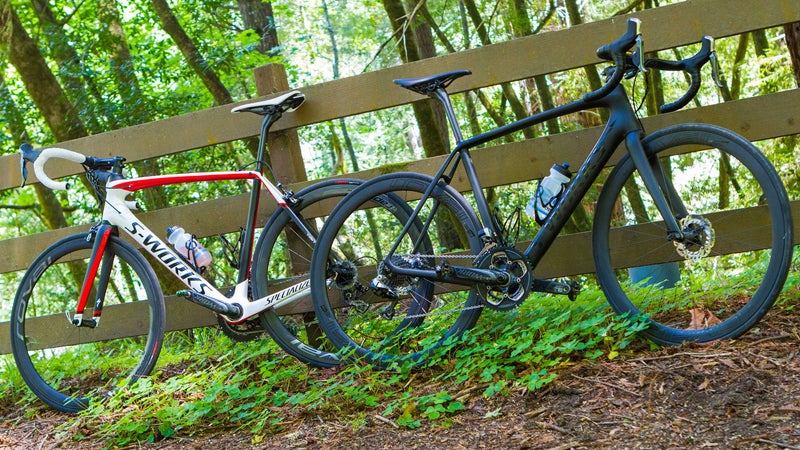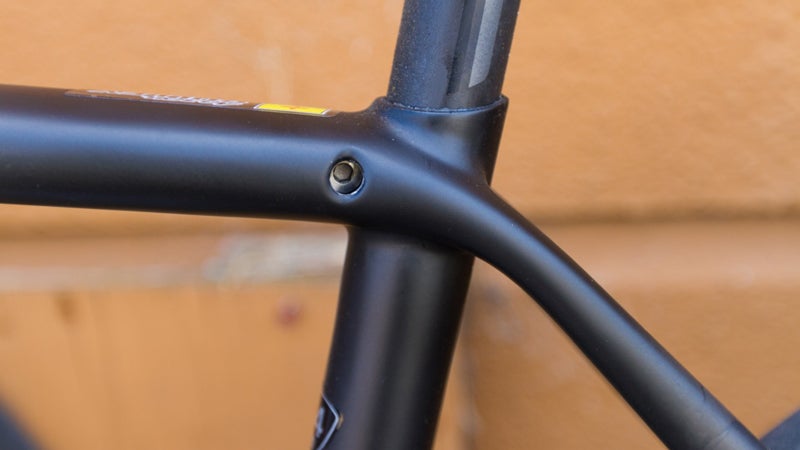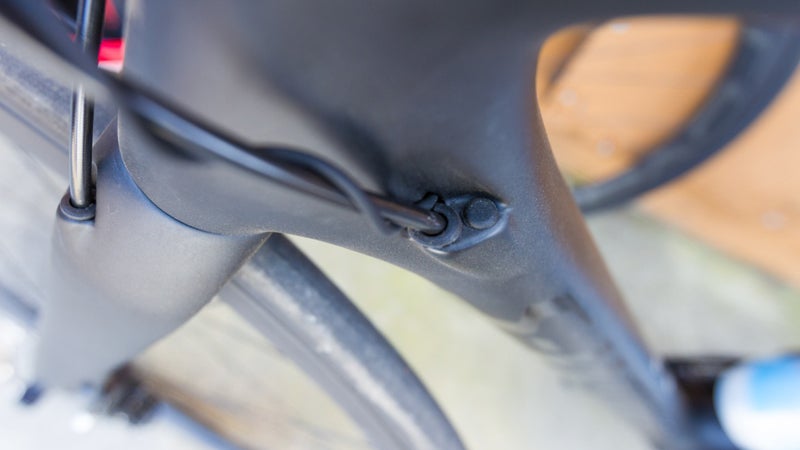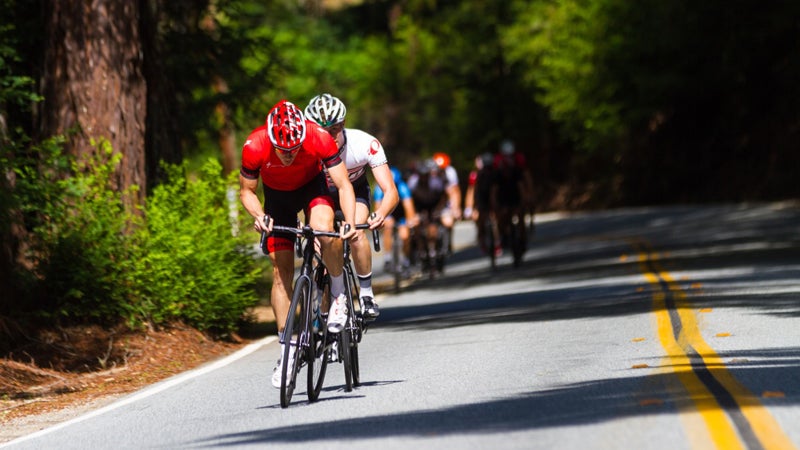It’s bike launch season, when manufacturers begin rolling out new models for the coming year. That’s right: even as we’re only finishing up with this year’s bikes, a whole new fleet is being assembled for 2015.
 The 2015 Specialized Tarmac, with disc brakes
The 2015 Specialized Tarmac, with disc brakes The 2015 Specialized Tarmac, with mechanical brakes
The 2015 Specialized Tarmac, with mechanical brakesSpecialized wouldn’t say what was in store for us ahead of their most recent road launch, which took place last week in Santa Cruz, just down the road from their Morgan Hill, California, headquarters. But that began surfacing from the Pro Tour ranks in recent weeks, I went in expecting the new Tarmac SL5. And that’s what Specialized unveiled—sort of.
Three years have passed since Specialized revamped its top-shelf race bike, which is quite a long interval for the company. “It has taken a while because we wanted to address who the rider is and what their needs are,” Chris Riekert, marketing manager at Specialized told us the first night we arrived. “We didn’t want it to just be ’10-percent stiffer and 10-percent lighter.’”
As Specialized tells it, the typical upgrade strategy employed by most bike manufacturers in recent years—Specialized included—of simply making a bike lighter and stiffer has reached its endgame. The company realized this in part when they received feedback from some of their pro riders, Alberto Contador in particular, that the was too stiff.

Around the same time, Chris d’Alusio, Specialized’s director of Advanced Research and Design, and Sam Pickman, an Advanced R&D engineer, had a revelation while out riding their SL4s together. Pickman is a lanky, big-boned guy who fits a size 58cm, while d’Alusio is short and slight and rides a 52cm. Both are accomplished racers and excellent riders. While the two were descending a sinuous, two-lane road in the rolling countryside near Morgan Hill, d’Alusio noticed that Pickman looked a bit uncomfortable and unsure of his lines. The two got to talking afterward and realized that their ride experiences on the SL4 were very different.
To grasp why that is, you have to understand the way that bike engineering works. In the past, when Specialized wanted to update a road bike, they set weight, stiffness, and compliance benchmarks for the project based on the previous model—the “10-percent-stiffer-and-lighter” adage referenced by Riekert.
Next they engineered a size 56cm frame, which is considered the middle of the road, to meet those new standards. And once they had a finished product they were happy with, they used extrapolations to scale the frame layups and tube diameters to the full size range.
The result? While a size 56 was sure to meet the new standards—even if those standards were arbitrary—other sizes were likely different. “Based on that model, the smaller bikes would end up stiffer and the larger bikes flexier,” d’Alusio explained. According to Specialized, every non-custom bike brand in the world uses some iteration of this system.
For the new Tarmac, the team at Specialized set out to quantitatively measure the forces a rider exerts on the bike in the field and then engineer each frame size to address those varied forces. They developed a framework of strain gauges that attached to multiple parts of the bike, including stem and seat post.
Those gauges then recorded the forces and sent them to a computer in real time. The measurements showed that while rider weight played a role in the force exerted on a frame, in fact rider size (the height of the rider) was an even bigger factor. Specialized then built each of the seven models (size 49 to 64) to specifically meet the stiffness and compliance benchmarks established by the data. “Using what we learned, we’ve reversed the curve. Bigger and taller riders get much stiffer bikes to address their needs, and smaller riders get more compliance,” d’Alusio said. “Most importantly, every rider should now have the exact same ride experience no matter what size bike they ride.”
Specialized calls the process Rider First Engineering, and while only the Tarmac will employ the system for now, it’s clear that the company plans to revamp other models using the same tests and criterion. In 2015, the top three models of the Tarmac (S-Works, Pro, and Expert) will get the new Rider-First-Engineered frame, while the four lower-tier models will continue forward as the SL4.
Specialized chose not to call the new model the SL5 in part because they see it as a very different creature from its predecessor and in part because they felt the nomenclature was getting out of hand. “It started seeming silly when we looked down the line and thought about the SL13 or the SL19,” Riekert said.
The biggest change to the new Tarmac is at the seat post junction, where an internal binder system has allowed Specialized to almost eliminate the tubing above the top tube, thus adding compliance to the frame. While much of the tubing looks similar to the past iteration, including a massive down tube and huge oversize bottom bracket area, the seat stays are more tapered and curved and the chain stays shift from a boxy profile to a more rounded shape—both of which add to ride comfort.

Specialized claims they have also used some of the shaping technology derived from the Venge to add small aerodynamic gains to the new Tarmac. Frame weights versus the SL4 vary by size, with the smallest frames lighter than before, the size 56 “within spitting distance,” according to d’Alusio, and the largest frames approximately 80 grams heavier.
In addition to a mechanical-brake version of the bike, Specialized is releasing a disc-brake equipped model. The inclusion of the new technology on a top-end race bike signals that Specialized believes that, sooner or later, the technology will likely be adopted by the UCI. Frame weights between disc and non-disc are virtually identical, though a complete size 56cm disc-equipped S-Works Tarmac will be approximately a pound heavier than the non-disc model.

In Santa Cruz, we spent two huge days in the saddle on the new bikes, the first on the disc model and the second on the mechanical. In terms of ride feel and handling, the bikes are virtually identical. However with over 10,000 feet of climbing and descending each day, everyone agreed that the braking performance of the discs was superior.
That was a bit of a revelation since many of the testers are racers, most of whom are skeptical of the need for discs. Other than the braking performance, the bikes have the same snappy responsiveness as the previous model, but feel more confident in the corners. It’s hard to tell without back-to-back comparisons, but most testers felt that the new Tarmac was also slightly less brassy and harsh than the SL4.
Pricing hasn’t been set for the new Tarmac, though it’s likely to be in line with current models, ranging from between $8,500 and $10,500 for the S-Works models down to $3,800 for the Expert. The bike debuted under all three of Specialized’s sponsored Pro Tour teams on stage one of the Giro d’Italia Friday, including Astana, Tinkov-Saxo, and Omega Pharma–Quick-Step. We’ll be taking delivery of one of the new bikes soon and will report back with a full ride review.


